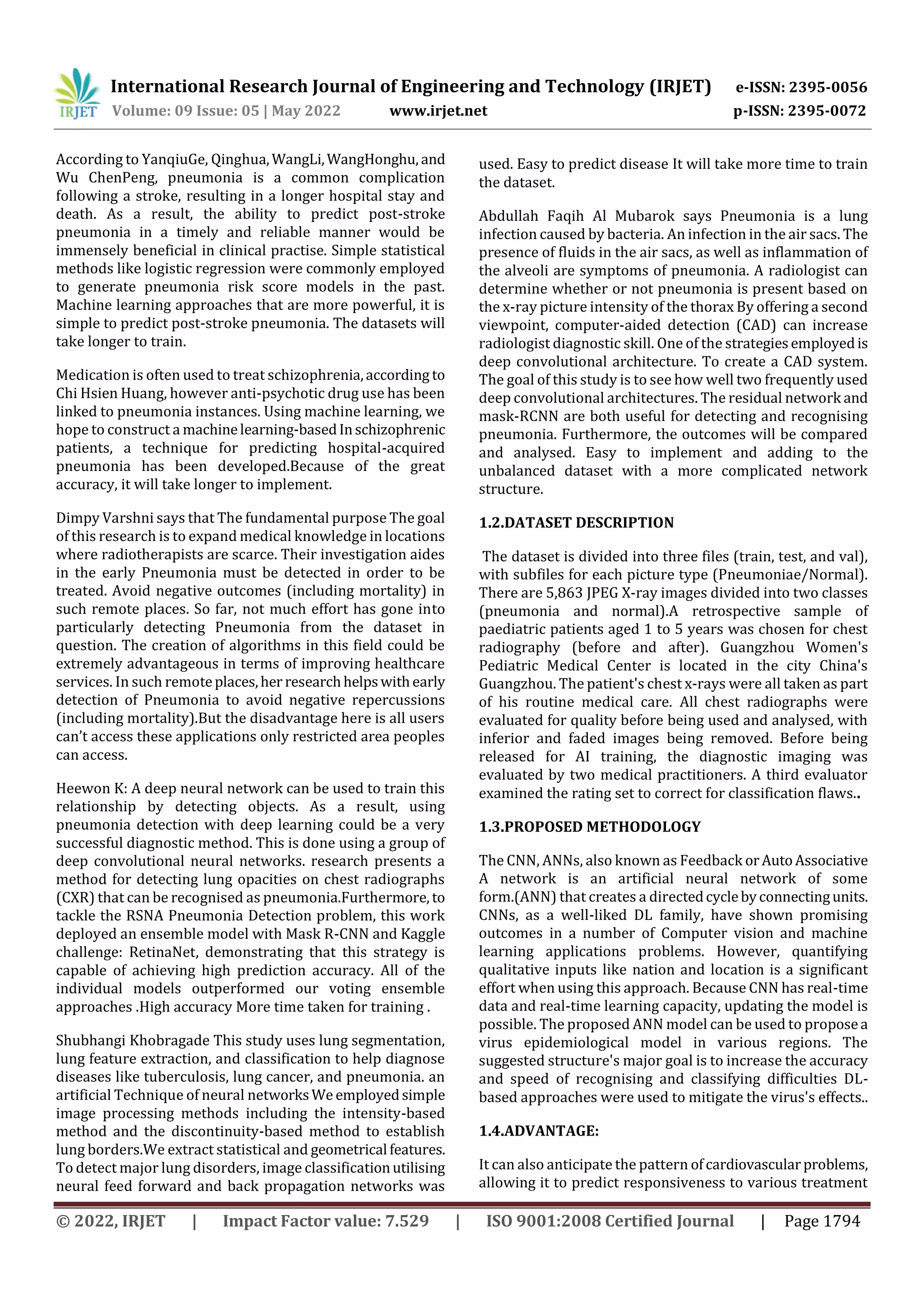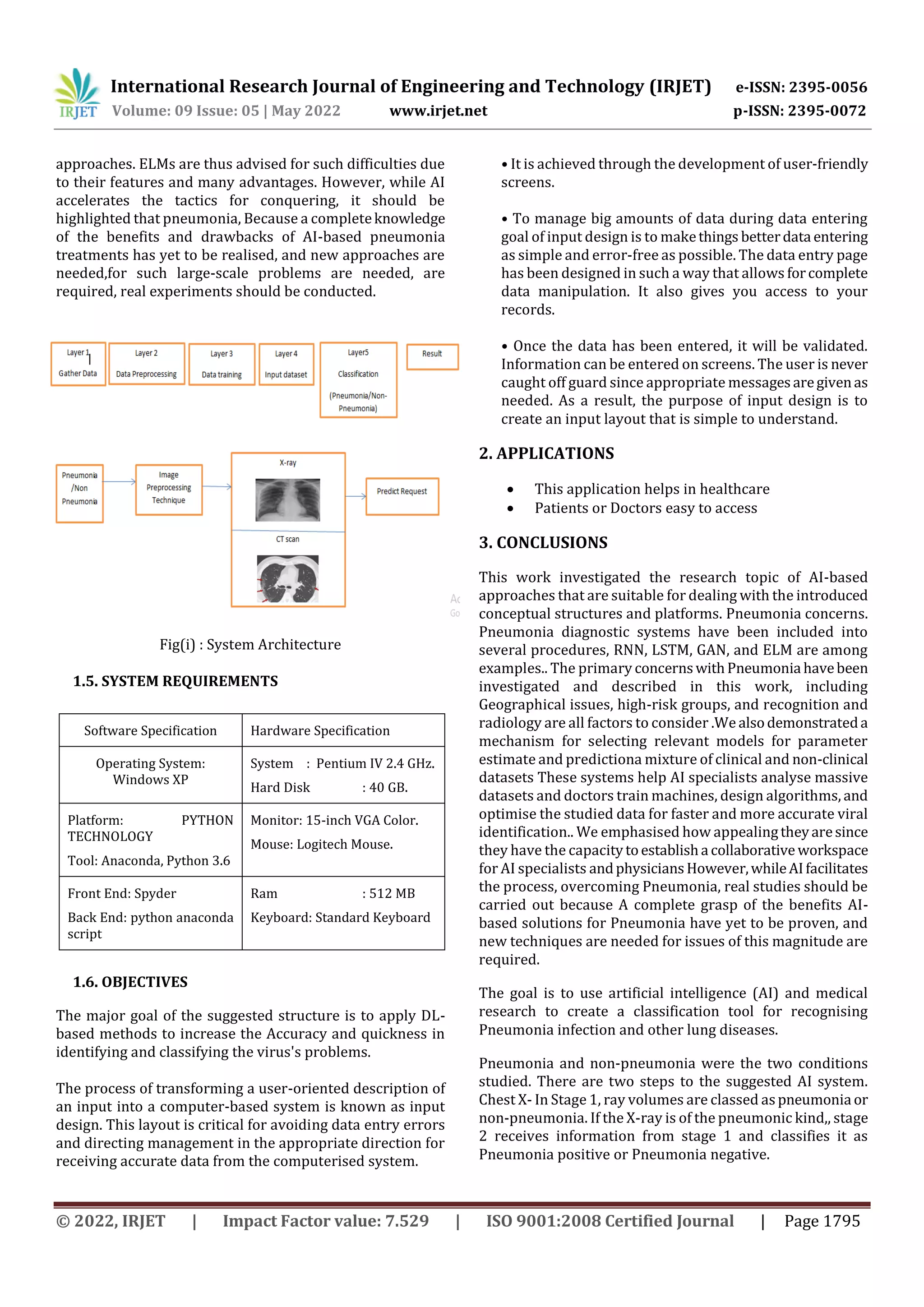This document discusses using convolutional neural networks to diagnose pneumonia from chest x-ray images. Specifically, it summarizes several research papers that used CNN models like InceptionV3 to extract features from x-ray images and then trained classification algorithms like support vector machines, neural networks, and K-nearest neighbors to classify images as pneumonia or normal. The neural network model achieved 84.1% sensitivity while support vector machines obtained the highest AUC of 93.1%. In general, CNNs can accurately diagnose pneumonia from x-rays but training the models requires a large dataset and computing resources.
![International Research Journal of Engineering and Technology (IRJET) e-ISSN: 2395-0056
Volume: 09 Issue: 05 | May 2022 www.irjet.net p-ISSN: 2395-0072
© 2022, IRJET | Impact Factor value: 7.529 | ISO 9001:2008 Certified Journal | Page 1793
PNEUMONIA DIAGNOSIS USING CHEST X-RAY IMAGES AND CNN
M S Naga Sathyashree1, Lavanya2, Manvitha B Patil3, Mounika V4, Dr.Kiran Kumari Patil5
1,2,3,4 Student, School of computer science and engineering, Reva University, Karnataka, India
5Director and Professor of UIIC, Reva University, Karnataka, India
---------------------------------------------------------------------***---------------------------------------------------------------------
Abstract - A pneumonia diagnosis system was developed
using convolutional neural network (CNN) based feature
extraction. InceptionV3 CNN was used to perform feature
extraction from chest X-ray images. The extractedfeature was
used to train three classification algorithm models to predict
the cases of pneumonia from the Kaggle dataset. The three
models are Support Vector Machines, NeuralNetworks, andK-
Nearest Neighbour The confusion matrix and performance
evaluation were presented to represent the sensitivity,
accuracy, precision, and specificity of each of the models.
Results show that . The sensitivity of the Neural Network
model was 84.1 percent, followed by support vector machines
(83.5 percent) and the K-Nearest Neighbour Algorithm (83.5
percent) (83.3 percent ). The Support vector machines model
obtained the highest AUC of all the classification models, at
93.1 percent.
Key Words: convolutional neural network, K-Nearest
Neighbour, InceptionV3 CNN, X-ray Images, Neural
Networks.
1. INTRODUCTION
Pneumonia is a commonillnessforthechildhoodcommunity
ranging from bacteria toviral pneumonia orthecombination
of both [1]. Pneumonia is life-threatening and one of the
primary causes of excessive child mortality rates in rural
settings. Accordingtothe WorldHealthOrganization(WHO),
pneumonia is responsible for one-third of all infantfatalities
in India [2].
The presence of an aberrant area known as lung opacity,
which looks opaque due to the attenuation ofthex-raybeam
in comparison to the surrounding tissues is required for the
diagnosis of pneumonia [3]. Traditional X-ray chest
radiography, Magnetic resonance imaging (MRI) and
computerised tomography(CT)scan(MRI)areall optionsfor
detecting pneumonia [4, 5]. Among these methods, X-ray
chest radiography is the most economical option compared
to other imaging diagnostics for pneumonia detection [6].
However, X-ray chest radiography is inferior in diagnosing
pneumonia, especially for patients below five yearsold.This
is due to the subtle differences in terms of scale, shape,
intensity, and textures, which complicates the diagnosis [7].
Besides, other illness such as lung scarring, and congestive
heart failure could also be misidentified as pneumonia [2].
Therefore, pneumonia diagnosis requires a skillful
radiologist X-ray of thechest todetectpneumonia symptoms
radiographs. The radiologist expert usually requires other
information from the patient, such as the detailed medical
record and phlegm condition [5].Itwouldbeadvantageous if
an automated classification system can be developed to
assist medical advisors or radiologists in the diagnosis of
pneumonia.
Since X-ray radiographs are essentially images, CNN can be
used to extract features VGG-16 and DenseNet-169, are
examples of XCeption.are some of the CNN models that have
been utilised for image identification of pneumonia [2, 3].
Rules-based, Bayesian network, Fuzzy C-means method, To
predict, support vector machines, Nave Bayers, K-Nearest
Neighbor, random forest, and other types of classifierscould
be employed. The case of pneumonia.andDecisionTree[2,8,
9]. Chapman and co-workers reported that the decision tree
attained a precision of 85%, followed by rules-based (80%)
and Bayesian network (72%), for the identification of
pneumonia [8]. However, most of the papers focused on the
feature extractions and did not evaluate the performance on
different classifiers [9, 10].
1.1Related work
J. Zhou and W. Ge proposed A common, deadly, but
preventable consequence of an Stroke-associated
pneumonia (SAP) (AIS) is a kind of acute ischemic stroke.
Identifying people who are most likely to develop SAP is
crucial. as soon as possible. On the other hand, Previous
clinical prediction methods have not been widely used.
practise. As a result, we set out to use machinelearning(ML)
techniques to create a model thatmay predict SAPinChinese
AIS patients .Although challenging to implement, the
XGBoost model, which comprises six common traits, can
ISAN and PNA scores do not accurately predict SAP in
Chinese AIS patients.
There is currently no equipmentavailableforearlydiagnosis
of pneumonia caused by using a ventilator, according to
Chung-Hung Shih and Yu-Hsuan Liao (VAP). As a result, he
recommends employing an offline gas detection device to
track the development of pneumonia metabolites and to
identify them early. The newmethodcollectsbreathsamples
from VAP patients using a e-nose with a low-costmicroarray
is simple to connect to an ICU mechanical ventilationsystem.
However, this is the standard approach of implementing
apps.](https://image.slidesharecdn.com/irjet-v9i5463-221005091355-ba733380/75/PNEUMONIA-DIAGNOSIS-USING-CHEST-X-RAY-IMAGES-AND-CNN-1-2048.jpg)


![International Research Journal of Engineering and Technology (IRJET) e-ISSN: 2395-0056
Volume: 09 Issue: 05 | May 2022 www.irjet.net p-ISSN: 2395-0072
© 2022, IRJET | Impact Factor value: 7.529 | ISO 9001:2008 Certified Journal | Page 1796
REFERENCES
[1] Virkki, R., Juven, T., Rikalainen, H., Svedström, E.,
Mertsola, J., and Ruuskanen, O., 2002. Differentiation of
bacterial and viral pneumonia in children, Thorax. 57, 438.
[2] Varshni, D., Thakral, K., Agarwal, L., Nijhawan, R., and
Mittal, A. Pneumonia detection using cnn based feature
extraction. in 2019 IEEE International Conference on
Electrical, Computer and Communication Technologies
(ICECCT). 2019.
[3] Ko, H., Ha, H., Cho, H., Seo, K., and Lee, J. Pneumonia
detection with weighted voting ensemble of cnn models. in
2019 2nd International Conference on Artificial Intelligence
and Big Data (ICAIBD). 2019.
[4] Khobragade, S., Tiwari, A., Patil, C. Y., and Narke, V.
Automatic detection of major lung diseases using chest
radiographs and classification by feed-forward artificial
neural network. 2016. IEEE 1st International Conference on
Power Electronics, Intelligent Control and Energy Systems
(ICPEICES).
[5] Mubarok, A. F. A., Dominique, J. A. M., and Thias, A. H.
Pneumonia detection with deep convolutional architecture.
in 2019 International Conference of Artificial Intelligence
and Information Technology (ICAIIT). 2019.
[6] Sharma, A., Raju, D., and Ranjan, S. Detection of
pneumonia clouds in chest x-ray using image processing
approach. in 2017 Nirma University International
Conference on Engineering (NUiCONE). 2017.
[7] G. d. Melo, S. O. Macedo, S. L. Vieira, and L. G. L. Oliveira
To diagnose pneumonia, photos are classified and
performance is improved using a parallel approach. IEEE
International Conference on Automation 2018/XXIII
Congress of the Chilean Association of Automatic Control
(ICA-ACCA).
[8] Chapman, W. W., Fizman, M., Chapman,B.E.,andHaug,P.
J., 2001. A comparison of classification algorithms to
automatically identify chest x-ray reports that support
pneumonia, Journal of Biomedical Informatics. 34, 4-14.
[9] Parveen, N. R. and Sathik, M. M., 2011. Detection of
pneumonia in chest x-ray images,JXraySciTechnol.19,423-
8.
[10] Karargyris, A., Siegelman, J., Tzortzis, D., Jaeger, S.,
Candemir, S., Xue, Z., Santosh, K. C., Vajda, S., Antani, S., Folio,
L., and Thoma, G. R., 2016. Combination of texture andshape
features to detect pulmonary abnormalitiesindigital chestx-
rays, Int J Comput Assist Radiol Surg. 11, 99- 106.](https://image.slidesharecdn.com/irjet-v9i5463-221005091355-ba733380/75/PNEUMONIA-DIAGNOSIS-USING-CHEST-X-RAY-IMAGES-AND-CNN-4-2048.jpg)